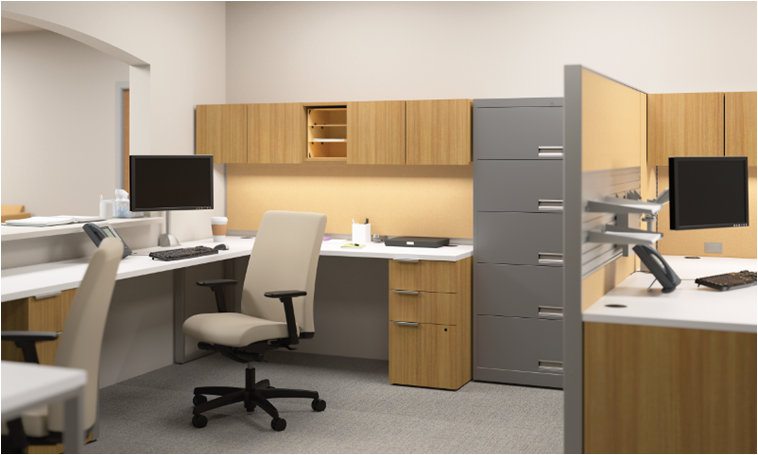The Impact of Lighting on Office Furniture Selection: Striking the Right BalanceThe Architecture Designs

In the realm of office design, the impact of lighting is often underestimated. Lighting not only influences the overall ambiance of a workspace but plays a crucial role in the selection and perception of office furniture. In this article, we delve into the symbiotic relationship between lighting and office furniture, emphasizing the importance of striking the right balance for a harmonious and productive work environment.
Understanding the Role of Lighting:
source: The HON Company
Lighting is a dynamic element that goes beyond mere illumination; it sets the tone for the entire workspace. Natural and artificial lighting affect the way furniture is perceived, influencing the color, texture, and overall aesthetic of the office. Recognizing the symbiosis between lighting and furniture is essential for creating a cohesive and visually appealing environment.
Natural Light Enhancement:
Natural light is a prized asset in office spaces, contributing to employee well-being and productivity. When selecting office furniture, consider how it interacts with natural light. Choose materials and finishes that complement sunlight rather than competing with it. Lighter-colored furniture can enhance the sense of openness and airiness, creating a welcoming atmosphere.
Color Temperature Considerations:
source: decoratedoffice.com
The color temperature of lighting impacts the way furniture colors are perceived. Warm lighting (yellow tones) can complement wooden furniture, creating a cozy and inviting ambiance. On the other hand, cooler lighting (blue tones) may enhance the modern aesthetic of metal or glass furniture. Striking a balance in color temperatures ensures that the lighting complements rather than clashes with the selected office furniture.
Task Lighting for Functional Spaces:
Task lighting is a critical component in workspaces where specific activities take place, such as desks, conference tables, or collaborative areas. When choosing office furniture for these spaces, consider how task lighting integrates into the design. Ensure that furniture layouts allow for the placement of task lighting where needed, providing optimal illumination for focused work or meetings.
Layered Lighting for Depth and Ambiance:
source: metroffice.com
A well-lit office employs a layered lighting approach, combining ambient, task, and accent lighting. This approach adds depth and ambiance to the workspace, influencing how furniture is visually perceived. When selecting office furniture, envision how it will interact with different layers of lighting to create a balanced and aesthetically pleasing environment.
Furniture Finishes and Reflection:
The finish of office furniture can influence how it reflects or absorbs light. Glossy finishes may reflect light, creating a sense of brightness and openness. Matte finishes, on the other hand, absorb light, contributing to a more subdued and cozy atmosphere. Consider the reflectivity of furniture finishes in relation to the desired lighting effect.
Artificial Lighting Fixtures as Design Elements:
source: erco.com
Lighting fixtures themselves can be considered design elements that complement office furniture. Pendant lights, chandeliers, or modern lighting fixtures can serve as focal points, enhancing the overall aesthetic of the workspace. Choose lighting fixtures that harmonize with the style and material palette of the selected office furniture.
Adjustable Lighting for Flexibility:
Flexibility in lighting is essential to accommodate diverse activities within the office. Adjustable lighting options, such as dimmable fixtures or movable task lamps, provide the flexibility to adapt the lighting environment to different tasks and moods. This adaptability ensures that the selected office furniture is showcased in the best possible light, figuratively and literally.
Conclusion:
The impact of lighting on office furniture selection goes beyond mere functionality; it shapes the overall atmosphere and perception of the workspace. Striking the right balance involves considering natural light enhancement, color temperature, task lighting, layered lighting, furniture finishes, lighting fixtures as design elements, and adjustable lighting for flexibility. By understanding the interplay between lighting and office furniture, organizations can create a workspace that not only meets functional needs but also fosters a visually cohesive, inviting, and productive environment for employees.
The post The Impact of Lighting on Office Furniture Selection: Striking the Right Balance appeared first on The Architecture Designs.





